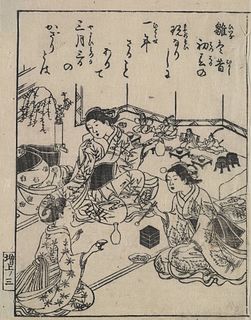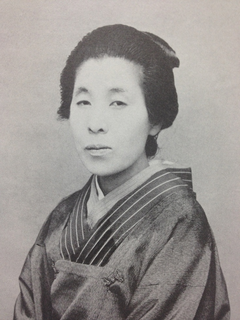 W
WTomohisa Kuramitsu, better known by his stage name Baiyon, is a Japanese multimedia artist from Kyoto. Baiyon uses graphical design and music in combination.
 W
WFujiwara no Sadaie (藤原定家), better-known as Fujiwara no Teika, was a Japanese anthologist, calligrapher, literary critic, novelist, poet, and scribe of the late Heian and early Kamakura periods. His influence was enormous, and he is counted as among the greatest of Japanese poets, and perhaps the greatest master of the waka form – an ancient poetic form consisting of five lines with a total of 31 syllables.
 W
WHanabusa Itchō was a Japanese painter, calligrapher, and haiku poet. He originally trained in the Kanō style, under Kanō Yasunobu, but ultimately rejected that style and became a literati (bunjin). He was also known as Hishikawa Waō and by a number of other art-names.
 W
WHata Teruo was a Japanese painter and graphic artist. In his works, he attempted to synthesize the nihonga and yōga styles. Many of his later works have Buddhist themes.
 W
WInagaki Chūsei, originally Kōtarō was a Japanese painter in the nihonga style. His younger brother, Inagaki Toshijiro, was a well-known woodcut artist and textile designer who was named a National Treasure.
 W
WIrie Hakō, originally Ikujirō was a Japanese painter in the nihonga style.
 W
WItō Jakuchū was a Japanese painter of the mid-Edo period when Japan had closed its doors to the outside world. Many of his paintings concern traditionally Japanese subjects, particularly chickens and other birds. Many of his otherwise traditional works display a great degree of experimentation with perspective, and with other very modern stylistic elements.
 W
WTsuji Kakō was a Japanese painter, trained by Kōno Bairei both in the Maruyama and Shijō schools of painting. His Zen training, which he started in 1899, influenced much of his painting style and led to his name being associated with the unconventional.
 W
WKanō Eitoku was a Japanese painter who lived during the Azuchi–Momoyama period of Japanese history and one of the most prominent patriarchs of the Kanō school of Japanese painting.
 W
WFuruya Kōrin was a Japanese artist, illustrator, and designer active in the Kyoto arts and crafts circle in the Meiji period of the late 19th and early 20th centuries. His pseudonym references Ogata Kōrin (1658–1716), also from Kyoto, and he described himself as a "Kōrin of the modern age".
 W
WMatsumura Keibun was a Japanese painter.
 W
WNakamura Daizaburō 中村大三郎 (1898–1947) was a Japanese painter active during the Taishō and Shōwa eras. He was born in Kyoto, the eldest son of a kimono dyer. He studied at the Kyoto Municipal School of Fine Arts and Crafts from 1912 to 1916. He then entered the Kyoto Municipal School of Painting, where he studied under Nishiyama Suisho, and was appointed to the faculty in 1925.
 W
WNishikawa Sukenobu , often called simply "Sukenobu", was a Japanese printmaker from Kyoto. He was unusual for an ukiyo-e artist, as he was based in the imperial capital of Kyoto. He did prints of actors, but gained note for his works concerning women. His Hyakunin joro shinasadame, in two volumes published in 1723, depicted women of all classes, from the empress to prostitutes, and received favorable results.
 W
WFelice "Lizzie" Rix-Ueno (1893–1967) was an Austrian textile, wallpaper, and craft designer. She lived in Japan, and became an influential figure in the Japanese modern art scene.
 W
WKitaōji Rosanjin was the pseudonym for a noted artist and epicure during the early to mid-Shōwa period of Japan. His real name was Kitaōji Fusajirō , but he is best known by his artistic name, Rosanjin. A man of many talents, Rosanjin was also a calligrapher, ceramicist, engraver, painter, lacquer artist and restaurateur.
 W
WTakeuchi Seihō was a Japanese painter of the nihonga genre, active from the Meiji through the early Shōwa period. One of the founders of nihonga, his works spanned half a century and he was regarded as master of the prewar Kyoto circle of painters. His real name was Takeuchi Tsunekichi.
 W
WReizei Tamechika also known as Okada Tamechika (岡田為恭) was a Japanese artist from the later Edo Period who was instrumental in reviving the classical style known as Yamato-e.
 W
WTomioka Tessai was the pseudonym for a painter and calligrapher in imperial Japan. He is regarded as the last major artist in the Bunjinga tradition and one of the first major artists of the Nihonga style. His real name was Yusuke, which he later changed to Hyakuren.
 W
WUemura Shōen was the pseudonym of an artist in Meiji, Taishō and early Shōwa period Japanese painting. Her real name was Uemura Tsune. Shōen was known primarily for her bijin-ga, or paintings of beautiful women, in the nihonga style, although she produced numerous works on historical themes and traditional subjects. Shōen is considered a major innovator in the bijin-ga genre despite the fact she often still used it to depict the traditional beauty standards of women. Bijin-ga gained criticism during the Taisho era while Shōen worked due to its lack of evolution to reflect the more modern statuses of women in Japan. During bijin-ga's conception in the Tokugawa, or Edo, period, women were regarded as lower class citizens and the genre often reflected this implication onto its female subjects. Within the Taisho era, women had made several advancements into the Japanese workforce, and artistry specifically was becoming more popular outside of pass times for the elite, which opened way for Shōen's success. Shōen received many awards and forms of recognition during her lifetime within Japan, being the first female recipient of the Order of Culture award, as well as being hired as the Imperial Household's official artist, which had previously only employed one other official woman in the position. In 1949 she died of cancer just a year after receiving the Order of Culture Award.
 W
WRyuzaburo Umehara was a Japanese painter who painted in the Yōga style.
 W
WWatanabe Shikō originally Kyūma or Motome was a Japanese painter of the Rinpa school. His other art names included Shōken (松軒) and Soshin (素信).
 W
WYamaguchi Sekkei also known as Yamaguchi Sōsetsu (山口宗雪) was a Japanese artist of the middle Edo period. He sometimes went under the names Baian (梅庵) or Hakuin (白隠).
 W
WYamaguchi Soken, also called Takejirō was a Japanese painter of the Shijō school. He was one of the "Ten Great Ones", taught by Maruyama Ōkyo.